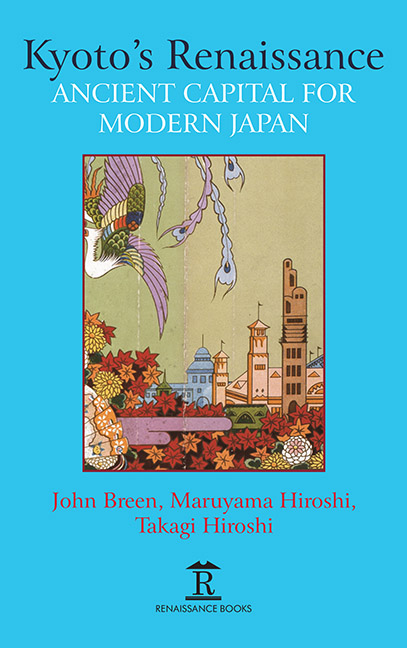Preface
Published online by Cambridge University Press: 30 April 2022
Summary
Kyoto's Renaissance: Ancient Capital for Modern Japan has its origins in a series of pioneering research seminars conducted at the University of Kyoto's Institute for Research in Humanities (Jinbun Kagaku Kenkyūsho), led by one of the editors of this volume, Takagi Hiroshi. The outcomes of these seminars were two books in Japanese that focused exclusively on Kyoto's modern history, Kindai Kyōto kenkyū and Miyako no kindai both published by Shibunkaku in 2008 and co-edited by Takagi Hiroshi with Maruyama Hiroshi and Iyori Tsutomu. Takagi Hiroshi subsequently edited a third collection of essays exploring the modern history of Kyoto alongside that of other cities such as Nara, Japan's other “ancient capital” (Kindai Nihon no rekishi toshi: koto to jōka machi. Shibunkaku Shuppan, 2013). The editors of the present volume are indebted to the work of all the scholars who contributed to these earlier volumes. Indeed, the research of several of these scholars appears in revised and updated form in the present volume.
All the chapters in this book, except that by John Breen, were originally written in Japanese. Takagi Hiroshi's contribution to the introduction and the chapters by Takagi Hiroshi and Kobayashi Takehiro were translated by Jennifer Shanmugaratnam; Tanigawa Yutaka's chapter was translated by Ryan Ward and John Breen; the chapters by Nakagawa Osamu, Takaku Reinosuke and Yoshii Takao were translated by Julian Holmes and John Breen; the chapter by Maruyama Hiroshi was translated by Stephen Gill; and the chapter by Kuniga Yumiko was translated by Simon Breen. All the translations into English were funded by a generous grant from the Institute for Research in Humanities, Kyoto University.
This book follows established practice in using the modified Hepburn system of Romanization. Note that all personal names are given in the traditional Japanese fashion of family name followed by given name. All dates are given in the Gregorian calendar.
The cover image is Yoshida Hatsusaburō's painting of the 1928 Kyoto Exhibition to commemorate the Shōwa emperor's enthronement of that year: Shōwa sannen tairei kinen Kyōto daihakurankai (Courtesy of Kyoto City Library of Historical Documents).
- Type
- Chapter
- Information
- Kyoto's RenaissanceAncient Capital for Modern Japan, pp. vii - viiiPublisher: Amsterdam University PressPrint publication year: 2020



